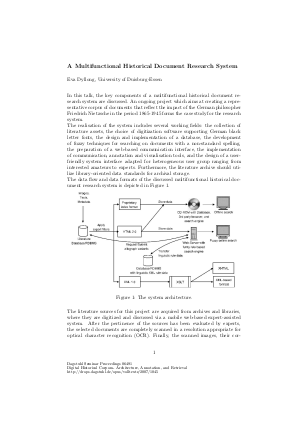A Multifunctional Historical Document Research System
Author Eva Dyllong
-
Part of:
Volume:
Dagstuhl Seminar Proceedings, Volume 6491
Part of: Series: Dagstuhl Seminar Proceedings (DagSemProc) - License:
 Creative Commons Attribution 4.0 International license
Creative Commons Attribution 4.0 International license
- Publication Date: 2007-06-13
File

PDF
DagSemProc.06491.4.pdf
- Filesize: 279 kB
- 3 pages
Document Identifiers
Subject Classification
Keywords
- Literature database
- digitization and archival storage
Metrics
- Access Statistics
-
Total Accesses (updated on a weekly basis)
0PDF Downloads0Metadata Views
Abstract
In this talk, the key components of a multifunctional historical document research system are discussed. An ongoing project which aims at creating a representative corpus of documents that reflect the impact of the German philosopher Friedrich Nietzsche in the period 1865-1945 forms the case study for the system. The realisation of the system includes several working fields: the collection of relevant historical documents, the digitization and choice of a suitable library-oriented data standards for archival storage, the design and implementation of a database, the development of fuzzy techniques for searching on documents with a non-standard orthography, the preparation of communication, annotation and visualisation tools, and the design of a user interface adapted for heterogeneous user group ranging from interested amateurs to experts.
Cite As Get BibTex
Eva Dyllong. A Multifunctional Historical Document Research System. In Digital Historical Corpora- Architecture, Annotation, and Retrieval. Dagstuhl Seminar Proceedings, Volume 6491, pp. 1-3, Schloss Dagstuhl – Leibniz-Zentrum für Informatik (2007)
https://doi.org/10.4230/DagSemProc.06491.4
BibTex
@InProceedings{dyllong:DagSemProc.06491.4,
author = {Dyllong, Eva},
title = {{A Multifunctional Historical Document Research System}},
booktitle = {Digital Historical Corpora- Architecture, Annotation, and Retrieval},
pages = {1--3},
series = {Dagstuhl Seminar Proceedings (DagSemProc)},
ISSN = {1862-4405},
year = {2007},
volume = {6491},
editor = {Lou Burnard and Milena Dobreva and Norbert Fuhr and Anke L\"{u}deling},
publisher = {Schloss Dagstuhl -- Leibniz-Zentrum f{\"u}r Informatik},
address = {Dagstuhl, Germany},
URL = {https://drops.dagstuhl.de/entities/document/10.4230/DagSemProc.06491.4},
URN = {urn:nbn:de:0030-drops-10456},
doi = {10.4230/DagSemProc.06491.4},
annote = {Keywords: Literature database, digitization and archival storage}
}
